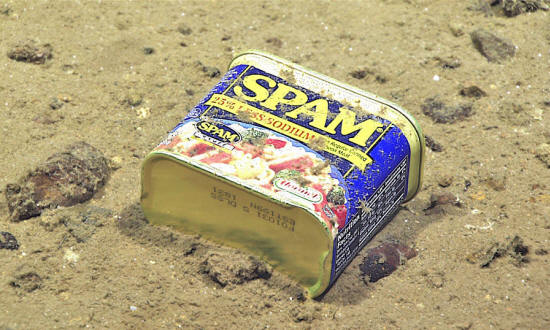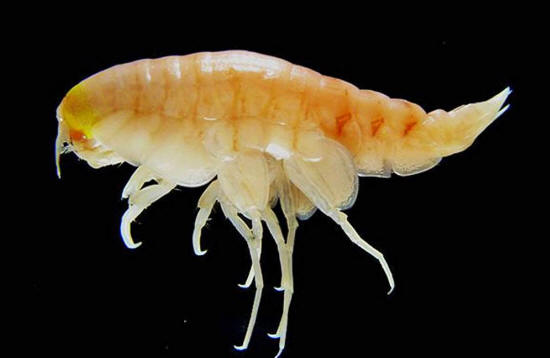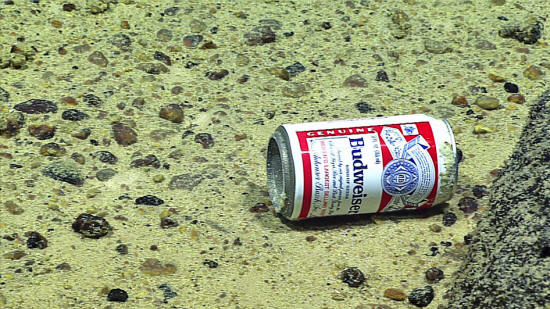|
by Jessica Hall
from
ExtremeTech Website
Yep, that's a can of luncheon meat from 2001, at 5 km down on the slopes of the Mariana Trench.
A recent submarine expedition to the deepest reaches of the ocean uncovered such sublime traces of human influence as flame retardant chemicals and other persistent organic pollutants (POPs), like, The team published their results (Bioaccumulation of Persistent Organic Pollutants in the Deepest Ocean Fauna) in the most recent issue of Nature Ecology and Evolution.
Congrats, guys. We did it. There's nowhere on our planet that humans haven't left their mark. We have now literally spammed the bottom of the ocean.
It seems obvious that the cans of beer and Spam probably fell off someone's boat.
But how did the runoff and smokestack chemicals get the whole way out there into the middle of the ocean? For one, they can disperse via wind and water, which accounts for how some of the POPs got into the sediment.
These chemicals are so long-lived that they can make it the whole way out into the middle of the Pacific without being materially changed or broken down by water treatment plants or the environment at large.
The study calls them,
Non-reactivity is the same quality that made PCBs valuable as dielectric fluid, used for "quenching" electrical discharge, and also what made PBDEs and chemicals like PFOS and PFOA useful as flame retardants.
Those ridiculously inert molecules just will not burn, conduct electricity or otherwise react. To get rid of them, you practically have to fire them into the sun.
We used them like they were going out of style until we found out they're carcinogenic with chronic exposure, and in high enough acute doses, they're ugly bad for the liver. As a consequence, production of both these POPs stopped decades ago.
But they're still in the deep ocean food chain, and the sediment on the seafloor.
One of the "voracious" invertebrate seafloor beasties that Jamieson and colleagues tested for POP contamination. Enlarged to show texture. Actual size: about 2cm.
We tend to regard the depths of the ocean as a sparsely populated wasteland, occupied by anglerfish and other horrors of the deep.
An area, in other words, generally apart from humanity's existence.
Isotope analysis from Fukushima showed it only takes a couple months, tops, to sink from the surface to the bottom - and it's probably faster for carrion falls, which are also a major source of bioaccumulating POPs in the food web.
POPs got into the food web because they're inert molecules:
When an animal eats something contaminated with POPs, they just sit there in its tissue, vaguely annoying its immune system and causing oxidative stress.
When it dies, those molecules of POPs are spatially concentrated, ready to be taken up by some other organism and absorbed into the food chain.
Instead of just remaining up here on land and in surface waters or near the shores, the POPs reached the ocean bottom by way of ocean currents and "marine snow," the detritus that filters down to the bottom from the surface.
When a POP-contaminated animal dies in the open ocean, the carrion slowly drifts down to the bottom, nibbled at the whole way by decomposers until a few contaminated flakes finally reach the seafloor, where they more or less stay.
That's how the PCBs got into the crustaceans and amphipods living at depths heretofore considered beyond the reach of human influence.
(Respectfully, Prof. Jamieson, you might still be amazed at the variety of things humans have left on the bottom of the ocean, including the world's first analog computer and so much ordnance from WWII.)
A Budweiser can seen at 3,780 meters depth at Enigma Seamount. Budweiser: the official beer of seafloor invertebrates.
In some crustaceans on the slopes of the Mariana trench, the highest levels of PCBs were 50 times more contaminated than crabs from paddy fields fed by the Liaohe River, a highly polluted rivers in China, the authors wrote:
The researchers also found severe contamination in amphipods collected in the Kermadec trench, which is in the North Pacific, 7,000 km from the Mariana trench.
The pollution was everywhere:
Like the ubiquitous anthropogenic lead contamination Clair Patterson discovered trying to find the age of the earth, PCBs and other POPs are candidates for a specific chemical marker of the hotly debated Anthropocene epoch.
The Anthropocene is a proposed division in the geological record of our planet, a literal and figurative line in the sand marking the emergence of humans as a species of global influence and worldwide dominance.
The fine but distinct layer of industrial pollution forms just as distinctive a signal that something has happened as the powdering of iridium that covered the entire planet after the K-T impact that killed the dinosaurs.
Just as researchers today can trace the K-T extinction event to that iridium layer, scientists ten thousand years from now will be able to track the appearance of pollutants like PCBs in the fossil record.
Hopefully we'll be able to track their disappearance as well...
|




